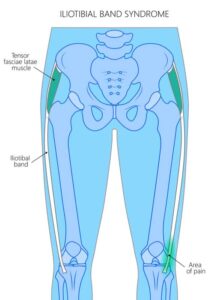Itliotibial Band Tenodesis Surgeon

Are you a younger patient and have you torn your ACL? A torn ACL in skeletally imature young patients can cause an additional knee condition called anterolateral knee instability. Young patients are often good candidates for a procedure called Iliotibial Band (ITB) Tenodesis. ITB Tenodesis can be done in conjunction with an ACL reconstruciton and will help stabilize the knee. Doctor Riley J. Williams provides diagnosis and tell you if you are a candidate for iliotibial band tenodesis for patients in Manhattan, Brooklyn, New York City and surrounding areas who have sustained an ACL injury and have knee instability. Contact Dr. Williams’ team today!
What is iliotibial band tenodesis?
Iliotibial band (ITB) tenodesis is a type of surgical procedure that used in conjunction with anterior cruciate ligament (ACL) reconstruction. ACL reconstruction surgery is commonly performed by replacing the damaged ACL with a tendon graft taken from another area of the patient’s own body (autograft) or from a donor (allograft). ITB tenodesis augments the ACL reconstruction, and involves taking a part or strip of the ITB leaving attached to its natural origin on the tibia. The harvested graft is passed beneath the lateral collateral ligament (LCL), and is ultimately secured on the lateral femur on the outer side of the knee. , Iliotibial band tenodesis can be a suitable treatment option in ACL surgery to increase knee stability and create a more stable ACL construct for active patients. ITB Tenodesis is also an effective methodology to use in patient undergoing revision ACL reconstruction. Dr. Riley J. Williams, orthopedic knee surgeon, serving Manhattan, Brooklyn, New York City, NY and surrounding areas, has extensive experience in ACL surgeries such as iliotibial band tenodesis.
Why is ITB tenodesis necessary?
Iliotibial band tenodesis may be a preferred method of knee stabilization in conjunction with ACL surgery, because this procedure has been shown to improve anterolateral knee stability. The anterior cruciate ligament is connective tissue that holds the femur (thighbone) and tibia (shinbone) together; the ACL provides knee stability during pivoting and rotational activities. When there is damage to this important ligament, knee instability results. Injury to the ACL can occur in an athletic population that requires cutting or a quick change in direction while playing sports. Restoration of knee stability following ACL injury is provided by reconstructing or replacing the native ACL; ITB Tenodesis can be used as a supplement to traditional ACL reconstruction methods.
Skeletally immature or young patients are often good candidates for ITB Tenodesis. When patients who are young tear their ACL, soft tissue graft are needed to reconstruct the ACL. Soft tissue grafts used for ACL surgery do not typically interfere with bone growth. In cases where ACL reconstruction must be done in young patients using a soft tissue graft (hamstring, quadriceps tendon), Dr. Williams will opt to supplement this ACL procedure with an ITB Tenodesis to achieve more durable and favorable results.
How is iliotibial band tenodesis performed?
ITB tenodesis is performed in an outpatient setting under local or regional anesthesia. When performed with ACL reconstruction, the ITB Tenodesis is done following the ACL surgery. A limited incision is made on the outer side of the knee. The ITB starts at the top of the hip and runs down just below the knee and is located on the outer side of the thigh. Dr. Williams will take a small strip of the ITB and pass it under the LCL. The ITB is then pulled and secured at the top of the outer knee (distal femur bone).
What are the risks of ACL surgery?
The risks of ACL surgery are low. Surgical procedures can always come with certain risks and include infection and blood clots. Anterior cruciate ligament surgery risks may also include knee stiffness, swelling, limited range of motion in the knee and even continued knee pain. It is important to follow Dr. William’s post-surgical protocols for ACL reconstruction and for ITB tenodesis to achieve the best possible outcomes.
How long does it take to recover from ITB tenodesis?
An individual will be able to go home within a few hours of surgery. He or she can expect to be on crutches for the first week after surgery; patients can put light weight on the knee. Pain, swelling and overall comfortability while bearing weight should be a patient’s guide to their healing process. Passive range of motion exercises can begin as soon as the day after surgery. Physical therapy is usually started 7-10 days after surgery. Individuals in New York and the surrounding areas should focus on range of motion, mobility, and strength training exercises within the first 6 weeks after surgery. Resistance exercises are be implemented by week three and are progressed throughout the entire rehabilitation process. Blood flow restriction (BFR) is recommended very early in the recovery process to support lower extremity strength and development. Patients can run by 3 months. A full return to normal sports and activities may be possible as soon as six months after combined ACL reconstruction and iliotibial band tenodesis.
For additional resources on iliotibial band tenodesis, ACL reconstruction surgery or to have your knee pain evaluated, please contact the office of Dr. Riley J. Williams, orthopedic knee surgeon serving Manhattan, Brooklyn, New York City, NY and surrounding areas.
